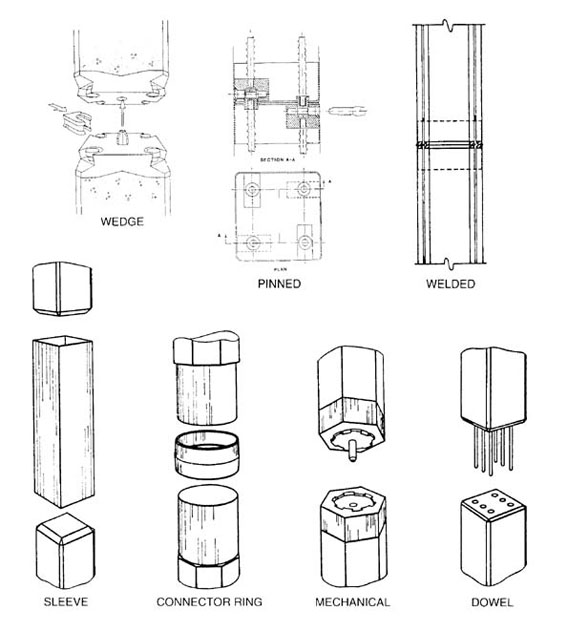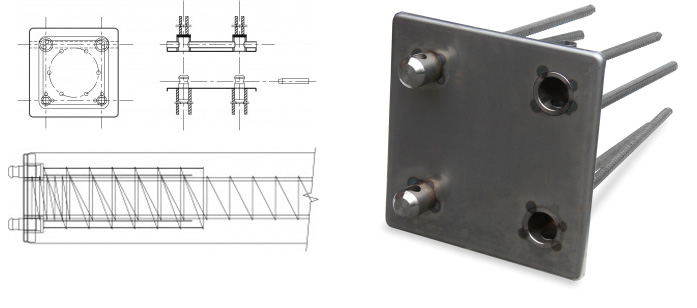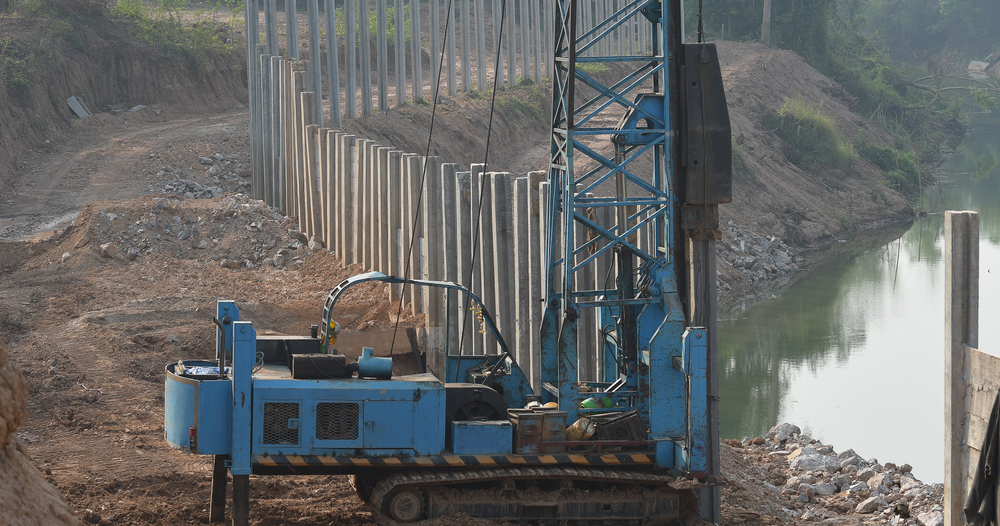Concrete Pile Splices
 Splicing is called for when pile lengths required are too long for trucking or driving in one piece with the available equipment, or if there is a headroom restriction. A pile may have one or more splices. The splice should be capable of resisting stresses induced by driving, and service loads and conditions. Tensile stresses are highest when resistance to driving is low and tensile waves are reflected back up the pile. Moment capacity is particularly important in high seismic zones, in piles possibly subject to impact, and in difficult driving conditions. Not all splices will develop tension and/or moment capacity.
Splicing is called for when pile lengths required are too long for trucking or driving in one piece with the available equipment, or if there is a headroom restriction. A pile may have one or more splices. The splice should be capable of resisting stresses induced by driving, and service loads and conditions. Tensile stresses are highest when resistance to driving is low and tensile waves are reflected back up the pile. Moment capacity is particularly important in high seismic zones, in piles possibly subject to impact, and in difficult driving conditions. Not all splices will develop tension and/or moment capacity.
SPLICES CAN BE GENERALLY CATEGORIZED AS FOLLOWS:
-
Welded: steel plates with attached rebar cast into the pile ends are field welded together. This method is rarely used in the US and Canada as it idles expensive field labor and equipment while the weld is performed.
-
Dowel: holes are cast or field drilled into the top of the bottom pile section. The top pile segment with rebar dowels protruding 1-2 meters from the end is guided into place and the grout or epoxy in the holes cures around the dowels. Although material cost is low, this method is infrequently used in the US and Canada as it requires that the pile top segment be held in place until the epoxy or grout cures. It is useful for “build-ups” — ex-tending a driven pile to required cut-off elevation with a short precast or cast-in-place section.
-
Sleeve: a “can” of steel 2-3 meters long with a stop in the middle. It slides over the driven section and the top pile section is then lowered into it and driving resumes. The splice is relatively economical and easy to use, but has very little bending and no tensile capacity.
-
Connector ring: a short length of pipe is cast onto each end of the usually square pile. A pipe pile splice is set on the driven section and the top pile segment is set into the sleeve. Intermittent fillet welds can be used to increase the limited tensile strength of the joint. This splice has been used extensively on Bruns piles in the New Orleans area; these splices both in the mould and in the field are shown below.
-
Mechanical: steel plates or castings with attached rebar anchors approximately 2 metres long are precast into the pile ends. Steel bars or “wedges” are inserted into the mating surfaces when the top pile segment is aligned on the driven section. This method is fast and extensively used in the US and Canada for prestressed piles since the 1970’s. Pro-prietary systems are predominant that utilize high-strength steel bars to lock machined plates together. The Sure-Lock mechanical splice is made for all sizes of piling (including some cylindrical piles) and can equal the pile in bending and tension capacities. This splice is shown below.

-
Post-tensioned: used in large diameter cylindrical piles. Multiple strand holes are cast longitudinally through the center of the concrete wall. After curing, the segments are aligned and strands are post-tensioned to hold the sections in one long pile section.
-
Wedge: This method is generally used with precast piles. An example of this is the Westpile, which utilizes a wedge driven on plates attached to the pile ends. This puts the connection at the corners to develop resistance at the extreme fibres. This is shown above.
-
Pinned: These use a pinned connection to secure the splice. These are generally not used in North America.
The ability of a splice to develop the strength of the pile, or a reasonable percentage of that strength, depends on close tolerance and proper procedures in making the splice. Careless workmanship or improper field procedures can result in significant deviations from strength and behaviour levels desired.
SURE-LOCK SPLICE


BRUNS PILES
Most of these types are illustrated below. Variations in construction with actual splices may be encountered.

Emeca/SPE USA
Emeca/SPE USA manufactures steel piling joints for casting into pre-stressed concrete piles for deep foundations. The sturdily-built, easy-to-install and cost-effective pile joint was developed by world leading piling specialists at Emeca Oy, in Finland.
Owner, Michael R. Jahnigen, a pioneer in the American pile driving industry, was so impressed with this innovative European product he brought it to the USA. Emeca/SPEUSA now has a patent pending for the Emeca products and sales territory consisting of North, Central and South America.
 These joints conform to the requirements of the International Building Code (IBC) and are manufactured in our automated, state of the art facility located in Laurel, Delaware, the first of its kind in the United States.
These joints conform to the requirements of the International Building Code (IBC) and are manufactured in our automated, state of the art facility located in Laurel, Delaware, the first of its kind in the United States.
Emeca/SPE USA belongs to the Sun Group of Businesses.
-
 SPW911 Sheet Pile Design Software
Rated 5.00 out of 5$150.00 – $599.99Price range: $150.00 through $599.99
SPW911 Sheet Pile Design Software
Rated 5.00 out of 5$150.00 – $599.99Price range: $150.00 through $599.99 -
 Sheet Pile Design (PDF Download)
Rated 5.00 out of 5$89.00
Sheet Pile Design (PDF Download)
Rated 5.00 out of 5$89.00 -
 Pile Driving (PDF Download)
$89.00
Pile Driving (PDF Download)
$89.00
-
 Marine Construction Volumes 1 & 2 (PDF Download)
$157.00
Marine Construction Volumes 1 & 2 (PDF Download)
$157.00
-
 Pile Driving (Book)
$89.00
Pile Driving (Book)
$89.00











